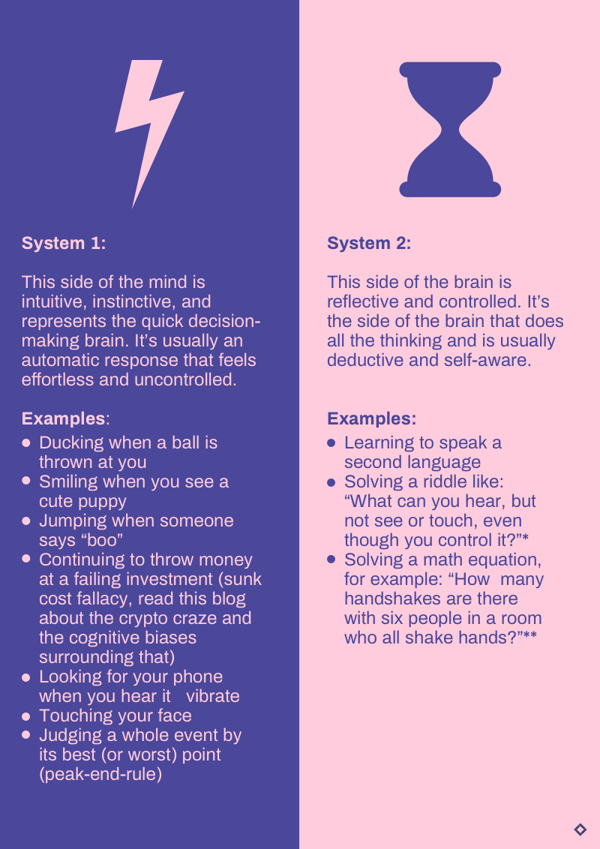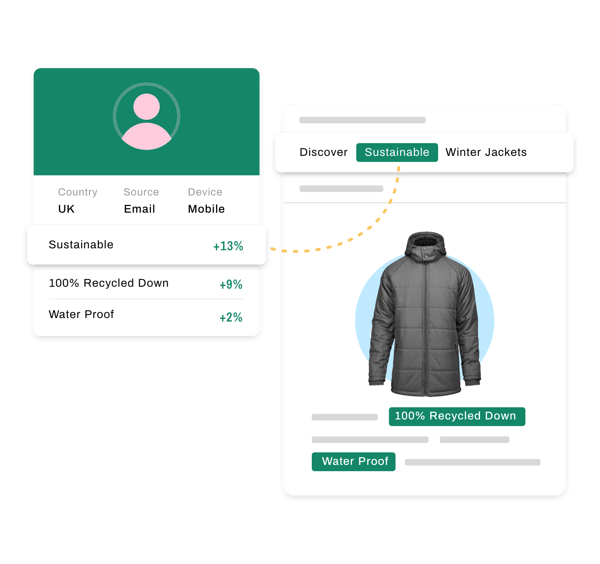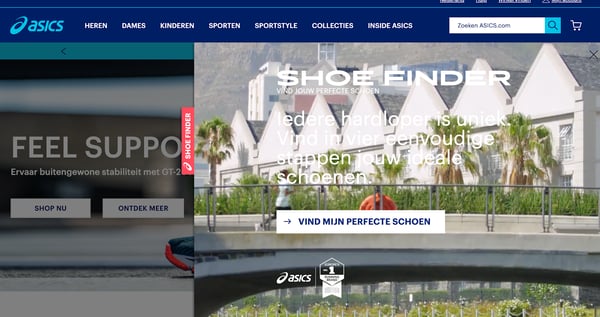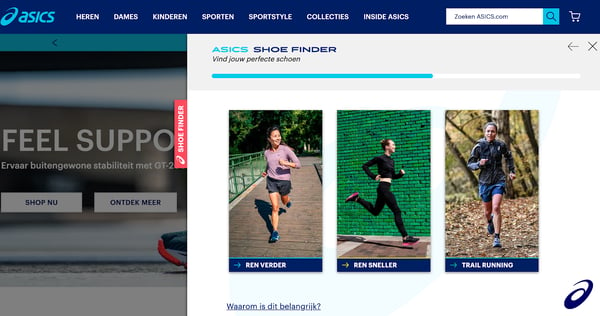Learn about the customer mindset through this customer-centricity case study with ASICS .

Learn about the customer mindset through this customer-centricity case study with ASICS .
Leading retailers today strive towards a customer-centric mindset by providing better customer experiences that are in line with the shopper's:
With more customers shopping online than ever before (and more choices at their disposal), adopting a customer-centric mindset is critical.
But achieving this can be harder than expected.
According to Acquia, 61% of shoppers feel that brands that know them don’t, not even at a basic level. Yet, 87% of marketers are confident they’re delivering a winning CX.
Many webshops are stuck on increasing conversions, pushing products, and selling, selling, selling, without thinking about the human experience.
What you need to bridge the gap between your marketing efforts and your shoppers’ feelings is to create a CX that’s in touch with the human side of your customers.
So where do you begin?
Today, I’m giving you a tried and tested approach to adopting a customer-centric mindset.
By leveraging neuroscience tools and shopper psychology to optimize your CX, you can begin to understand your shopper’s behavior on a deeper level.
This article will also give you a unique example of where neuroscience and psychology have combined forces to optimize the retailer ASICS’ CX, resulting in incredible ROI results.
Here’s what we’ll cover:
 “Many brands aren’t aware of the benefit of humanizing their data sets. To try to rationalize everything is a downfall because humans aren’t rational beings. By using psychology and neuroscience you get a lot more insights into the way people behave, but also why they behave the way they do. Enriching the existing data sets with this human behavior data is what is giving companies a head start.” - Eltine van der Veer, Head of Experience & Insights at Braingineers
“Many brands aren’t aware of the benefit of humanizing their data sets. To try to rationalize everything is a downfall because humans aren’t rational beings. By using psychology and neuroscience you get a lot more insights into the way people behave, but also why they behave the way they do. Enriching the existing data sets with this human behavior data is what is giving companies a head start.” - Eltine van der Veer, Head of Experience & Insights at Braingineers
The other day I was navigating a webshop and got stuck looking at two different products.
One had clear product information, including sizes and material, but no color options or reviews.
The other had many reviews, but limited product information.

Decision stress, choice overload, hesitation, insecurity: These are just some of the psychological barriers shoppers experience whilst navigating a webshop that’s not customer-centric.
Ultimately, the store couldn’t help me decide about my purchases, which means I’m unlikely to retrieve my products or even shop with the brand again.
It may sound harsh - but it’s a harsh reality.
Although I’m infamously indecisive, I’m not the only shopper who leaves abandoned carts:
It takes a user less than 15 seconds to bounce from a webshop if it doesn’t capture their attention.
So how do you capture the attention of your shoppers and help them make better purchasing decisions that are in line with who they are as individuals?
Firstly, it’s about looking at who your shoppers are as people, not users.
It’s about understanding what makes them tick, and what makes them click, on a subconscious level.

Many shoppers can’t say why they’re unable to decide between two products.
Plus, most decisions are implicit and center around the System 1 process.
That’s why neuroscience and psychology are necessary to understand your customer’s mindset because, in most cases, your customers can’t explain these behaviors themselves.
People carry out around 95% of all decisions subconsciously. If we didn’t, we’d constantly over rationalize and weigh all our options out forever.
We’d never get anything done.

That being said, we use our System 1 way of thinking to streamline these decisions.
According to behavioral economist Daniel Kahneman, System 1 is the unconscious, reflexive, and instinctive process in the brain.
Unlike System 2, which is reflective and rational, System 1 helps us react quickly.
System 1 and System 2 were developed by behavioral economist Daniel Kahneman in his 2011 book Thinking Fast and Slow.

“The law of least effort...asserts that if there are several ways of achieving the same goal, people will eventually gravitate to the least demanding course of action. In the economy of action, effort is a cost...Laziness is built deep into our nature.” -Daniel Kahneman
The brain uses mental shortcuts (i.e., heuristics) that operate as a baseline for our System 1 decision-making.

Very Well Mind: Heuristics and Cognitive Biases
These biases are what fuel our everyday life. They are cognitive shortcuts so we don’t have to consciously make our minds up every time we are faced with a decision.
E.g.,:
While neuroscience can show you how people use mental shortcuts by looking at the brain’s behavior, psychology can give you insights into the why behind these behaviors.

The Brave New World of Neuromarketing
Neuroscience is the scientific study of the brain and the reactions tied to its subconscious processes.
Neuromarketing is the output of this study, examining how the brain’s responds to branding, marketing, or products by measuring neural activity.
In short,
So how does it work?
Neuromarketers use a combination of objective tools that rely on neuroscience theories to collect and analyze behavioral data. Or, in other words, the real-time data that will give clues about the System 1 processes.
Here are some of those tools.

Heat maps measure where people scroll and click on a webshop, including looking at how people move in general across landing pages.
Hotjar, for example, generates graphic representations of data values in color.
The most popular areas of the page will be red and the least popular will be blue.
With this data, they can reveal:
1. Parts of the webshop are bottlenecks in the UX
2. Parts draw the most subconscious attention.
Since most of us navigate a webshop without thinking twice about it, heat maps can reveal the implicit biases behind our quick decision-making.

Eye-tracking works in a similar way and the two are often used interchangeably or on top of each other.
EyeQuant, for example, is an eye-tracking tool that can quantify people’s gaze patterns (e.g., quick eye movements, fixations, smooth pursuits).
In doing so, they can see where people focus their attention, including which areas cause friction.
If you know that some of your shoppers linger on your SALE section, you can infer they are deal-driven.
While neuroscience can reveal the behavior of shoppers, psychology will take it to the next step and make assumptions about that behavior (we’ll see how later on).
Braingineers offers a neuromarketing tool that tests the neuro usability of eCommerce webshops using a combination of EEG, eye-tracking, click-tracking, and neurofeedback.
So while heat-maps and eye-tracking technologies are great for those quick conversion wins, you still don’t know what happens in the mind of the person displaying the behavior.
Which means you could go all out by combining tools or leveraging EEG or fMRI. But fMRI is expensive, and can’t be used to test a webshop.
EEG can measure those second-by-second interactions across multiple touchpoints.

Seems pretty futuristic, right? But how does it work?
When people interact with a website, their emotions respond according to their experience.
The brain fires neurons that can be read as electrical currents.
EEG scans pick up on this electricity, analyzing which parts of the brain they come from.
From this, Braingineers, for example, has created an emotional detecting algorithm that measures:
 From Brainpeek
From Brainpeek
Cool, right? But wait - it gets better.
Braingineers use a combination of:
1. Implicit analysis (EEG scans, click-tracking, eye-tracking to analyze System 1)
2. Explicit (conscious neurofeedback) to generate a holistic picture of a test subject as they navigate a website.
“For example, if a participant has experienced a significant peak in frustration on the product detail page,” explains Braingineers research lead Sam Goos, “then we ask the participant “can you explain what you experienced here”. This gives us a little more context about the data on-screen”.
They quite literally put the human back in data: By measuring the subconscious experience, they can eliminate subjectivity and optimize their datasets with direct input from the brain.
“We use EEG emotion tracking as an objective technique to measure the UX, rather than the opinion of the researcher or participants themselves,” explains Sam Goos, “this is what makes the research extremely objective.”
According to an article in Harvard Business Review, emotionally connected customers are twice as valuable as highly satisfied customers.
If you can tap into the subconscious buying experience, then you can understand what emotional as well as cognitive biases govern your shopper’s experience.
By leveraging emotional mapping, therefore, Braingineers can read how people’s brains react as they navigate a website.
For the biases we discussed, plus many more, there is a wealth of theory.
The main one we are addressing today is the decision-making process: Researchers have found that specific biases lead to making certain decisions.
You may think you’re making a neutral, unbiased decision, but only about 5% of your 35,000 choices per day will actually use System 2.
The rest rely on System 1, which uses mental shortcuts, otherwise known as cognitive biases to function.
Neuroscience is powerful because it gives insights into how people make decisions using System 1. But without psychology, you can’t adopt a customer-centric mindset. You need to put this behavior into context, psychology gives you the tools to do just that.
When you gain an understanding of these biases, you can begin to create enjoyable and stress-free experiences for every individual who lands on your webshop and continues to discover and explore your products.
It could be as simple as using certain banner images, colors, fonts, or CTAs. Or, it could be as complex as adopting personalization.

From Sendpulse
With A/B Testing, for example, you can learn what makes an individual click on your CTAs.
Your subtle elements of design are the areas that appeal to System 1 psychology.
If you know that people respond to a statement rather than a question in your CTAs, for example, then you can optimize your future email campaigns with statement CTAs to drive people to your webshop.
Or, you can test a drop-down vs. a top menu bar for your product taxonomies. A/B testing can help optimize the entire CX, from persuasive copy to site functionalities and search navigation.
The more relevant these design choices, the more you can streamline decision-making. This is a great way to adopt a customer-centric mindset by testing if your design is in line with your customer’s choices and shopping goals.

From YotPo
Reviews on your webshop are great to see what your customers think about your products. But they also leverage Social Proof, which can help you understand the why behind the buy.
YotPo, for example, makes leaving reviews easier. They generate a rating based on the shopper’s feedback. With that, then can say which attributes are appealing to the individual and which aren’t.
Not only is this a great way to help other shoppers make peer-informed decisions about their purchases, but retailers can also see what attributes of the product facilitate these decisions, and which don’t.
Leveraging Social Proof psychology in this way can be a huge benefit for both product promotion, conversion, and even creation.

Another way to facilitate decision-making is through personalization. This seems like an obvious one: The more tailored the on-site communication is, the more seamless the buyer’s journey.
But how does it work?
One way of doing this is by using Dynamic Messaging. At Crobox, for example, we leverage AI to select the best product messages (e.g., premium, quality, bestseller, new) based on the individual looking at the product.

Crobox’s Dynamic USP badges on IKEA’s PDP
This way, we’re able to highlight products on the PLP and inform shoppers of what they want to know on the PDP (read about product vs. customer-centric).
We test these messages to see their influence on CTR, CVR, add-to-cart, etc. If you can understand that your shoppers add a product to cart because it’s of premium quality, this shows what attributes appeal to individuals.
Sure, these kinds of insights will turn browsers into buyers, but they’re also important to give data that human touch.

Crobox Dynamic Badges on ASICS' PLP
For example, if your “Bestseller” Dynamic Badge on the PLP has increased click-behavior for your UK shopper segment coming from email, then you can create an email campaign for this segment leveraging Social Proof.
Regardless of the approach, you take when leveraging psychology on-site, you should always consider the differences between your customers and try to deliver the experience that benefits most, if not all, of your shoppers.

It’s by digging deeper into these insights that you can start to put them into context, and that’s where psychology steps in.
To sum up, there are two techniques you can leverage when adopting a customer-centric mindset:
Combining both neuroscience and psychology can create meaningful and lasting customer experiences.
But don’t just take it from me.
If you really want to see this customer-centric mindset at work, let’s take a look at how Crobox and Braingineers joined forces to optimize ASICS’ Shoe Finder.
Adopting a customer-centric mindset starts by putting yourself in your customer’s shoes: What do they look for when they browse a webshop? How do they browse your webshop?
And most importantly, what’s missing in their online customer experience?
These questions were top-of-mind for ASICS, who wanted to create an online shopping wizard (i.e., their Shoe Finder tool) to personalize their CX.
According to ASICS’ Senior eCommerce Manager, Rick Hoving,
“The whole idea behind the Shoe Finder was to bring our in-store guided selling to the online environment.”
What is guided selling? Read out Crobox's holistic guide.

The Shoe Finder emulates an in-store assistant to help customers find the perfect shoe that fits their running goals.
To test the usability of the Shoe Finder, Braingineers was brought in to carry out neuro-usability research, using EEG, eye-tracking, and click-tracking (measuring the implicit decision-making process).
Crobox then optimized the Shoe Finder from its 1.0 version to 2.0 to make sure the 2.0 version was in tune with ASICS customers. Currently, ASICS is carrying out UX tests to continuously test and improve the Shoe Finder tool.


“We already had the Shoe Finder 1.0 for over a year, so we knew it had limitations. Flat analytics and data give us an idea of how it worked, but what was missing was the user’s emotions and personal experience. There’s a lot of gut feeling that goes into reusing this objective data in an actionable way. We really needed these psychological and neuro-insights to see the parts in the Shoe Finder our shoppers were struggling with.” -Rick Hoving, Senior eCommerce Manager at ASICS
Using data from Braingineers research and Crobox’s Dynamic Messaging experiments, ASICS tailored the Shoe Finder question and made the design more personalized, user-friendly, and customer-centric.
Braingineers experiments revealed that the Shoe Finder was hard to find on the ASICS homepage.

The EEG scan noted a peak in Attention and Frustration at not being able to reach their goal. Eye-tracking also revealed the Shoe Finder banner and menu bar were often overlooked.
This was confirmed by the neuro-feedback, “I was looking for the tool to help me choose the right shoe. When I scrolled all the way down I hadn't found it yet. I found that annoying.”

Shoe Finder 2.0 on ASICS UK webshop
Following this, Crobox optimized the Shoe Finder to make it a pop-up that can always be seen on the right of the screen and minimized easily. The banner color was also changed to red to attract attention.

Another part Braingineers tested was the Shoe Finder CTA copy. A few participants experienced Frustration and it was key to figure out why and how to change this.
For example, eye-tracking revealed that a few participants read the header and other text on the landing page, instead of being immediately drawn to the CTA.
Findings revealed a lot of other distractions on this page, which prevented the user from reaching their ultimate goal, which was to find their perfect running shoe.

Crobox changed the original CTA from “Get to work” to “Find My Perfect Running Shoe”.
By tweaking the copy to “my perfect running shoe”, the product becomes endowed to the customer, leveraging the psychological bias of the Endowment Effect in the CTA to make it more personalized.
“Find” is also used in the copy as this relates back to the tool (the Shoe Finder). The CTA now is more compelling as it’s in line with the goals of the user.

Another insight was that in the Shoe Finder 1.0, Frustration occurred because participants did not have a "Trail Running" option.
This showed how many people were interested in trail running shoes, but the Shoe Finder didn’t provide products for this shopping intent. It also revealed that the question created a lot of hesitation for participants.

In the Shoe Finder 2.0, a trail running option was integrated into the Shoe Finder. This filled a gap many shoppers were missing, whilst providing more product options for the trail running segment.
Interestingly, this also showed ASICS that trail shoes are a popular option. ASICS can reuse these insights to create campaigns for trail runners or retarget trail runners on-site.

“Each neuro usability study consists of ten participants. In this case, we had a specific target group, namely a mix of both experienced and inexperienced runners. After conducting the research, we analyzed the data and thus were able to find out where the Joy, Attention, and Frustration arose. We discussed the research findings and suggestions coming from these insights in a digital session with both Asics and Crobox. They then got to work on it.” -Sam Goos, Research Lead at Braingineers
These are just some of the insights from the experiments. But, as you can imagine, there were a lot of changes implemented to improve the Shoe Finder to what it is today.
In short, combining neuroscience tools and psychological insights, ASICS was able to increase the findability, usability, and flexibility of their Shoe Finder.
Compared to the Shoe Finder 1.0, the 2.0 version generated incredible results in just the first month:

Leveraging neuroscience tools and psychology, ASICS could facilitate a customer-centric experience on-site.
They went in with a customer-centric mindset by asking: How can we improve our shopper’s experience online?
And by asking “how” they were able to understand, test, and then optimize.
“Our [Crobox x Braingineers] shared backgrounds in psychology and understanding of it is how we really benefit from our combined experiences. But it’s in our technology where we differ - and complement each other.” -Patrick Oberstadt, Consumer Psychologist at Crobox
Adopting a customer-centric mindset can be challenging in the eCommerce space. But if your business is open to innovation and flexible to adopt new tools, then you will immediately see increased ROI.
By understanding how your shoppers make decisions, you can begin to drive behavior on your webshop.
You can create products that are in line with their motivations and preferences. All whilst tailoring your communication and personalizing your CX.
This article has only touched the tip of the iceberg when it comes to leveraging neuroscience and psychology for retail. But with a case study that proved incredible results, it’s now up to you to seize similar opportunities.
The future of customer-centricity lies in your hands.
No pressure ;).